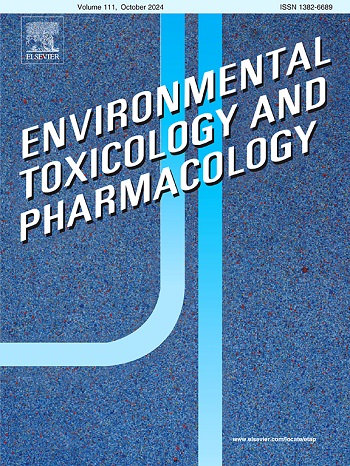Morphological and functional response of Mytilus galloprovincialis exposed to the Enalapril metabolite, Enalaprilat
IF 4.2
3区 环境科学与生态学
Q2 ENVIRONMENTAL SCIENCES
引用次数: 0
Abstract
The increasing presence of antihypertensives and their metabolites in the aquatic environment is giving rise to considerable concern, due to their potential effects on non-target organisms. We here assessed whether and to what extent the exposure to Enalaprilat, the main metabolite of the Angiotensin Converting Enzyme (ACE) inhibitor Enalapril, induces morpho-functional alterations in the mussel Mytilus galloprovincialis. The effects of 10-days exposure to 7 ng/L (ET1) and 7000 ng/L (ET2) of Enalaprilat were analyzed in the digestive gland (DG) in terms of cell viability, and cell volume regulation, and in both DG and gills in terms of tissue morphology, oxidative stress and stress protein expression. Results indicated that Enalaprilat did not compromise the viability of DG cells and haemocytes, as well as the capacity of DG cells to regulate cell volume. Morphological analysis revealed an increase in eosinophilia, indicative of an inflammatory response activation, in the connective tissue of DG from ET1 group, and a loss of epithelial integrity in gills. No changes were observed in both DG and gill extracts in the relative transcript abundance of hsp70, neither in the relative protein expression, while a tissue-specific modulation of antioxidant enzymes CAT and SOD was observed in gills and DG. Overall, our data suggest that environmental exposure to Enalaprilat, by activating inflammatory and oxidative stress responses, may potentially affect animal homeostasis.
对依那普利代谢物依那普利的形态学和功能反应。
由于抗高血压药及其代谢物对非靶生物的潜在影响,水生环境中抗高血压药及其代谢物的增加引起了相当大的关注。我们在此评估了暴露于依那普利(血管紧张素转换酶(ACE)抑制剂依那普利的主要代谢物)是否以及在多大程度上诱导了贻贝M. galloprovincialis的形态功能改变。分析了7ng/L (ET1)和7000ng/L (ET2)依那普利拉对消化腺(DG)细胞活力和细胞体积调节的影响,以及对DG和鳃组织形态、氧化应激和应激蛋白表达的影响。结果表明依那普利特不影响DG细胞和血细胞的活力,也不影响DG细胞调节细胞体积的能力。形态学分析显示,ET1组DG结缔组织中嗜酸性粒细胞增加,表明炎症反应激活,并且鳃中上皮完整性丧失。在DG和鳃提取物中,hsp70的相对转录物丰度和相对蛋白表达均未发生变化,而在鳃和DG中观察到抗氧化酶CAT和SOD的组织特异性调节。
本文章由计算机程序翻译,如有差异,请以英文原文为准。
求助全文
约1分钟内获得全文
求助全文
来源期刊
CiteScore
7.00
自引率
4.70%
发文量
185
审稿时长
34 days
期刊介绍:
Environmental Toxicology and Pharmacology publishes the results of studies concerning toxic and pharmacological effects of (human and veterinary) drugs and of environmental contaminants in animals and man.
Areas of special interest are: molecular mechanisms of toxicity, biotransformation and toxicokinetics (including toxicokinetic modelling), molecular, biochemical and physiological mechanisms explaining differences in sensitivity between species and individuals, the characterisation of pathophysiological models and mechanisms involved in the development of effects and the identification of biological markers that can be used to study exposure and effects in man and animals.
In addition to full length papers, short communications, full-length reviews and mini-reviews, Environmental Toxicology and Pharmacology will publish in depth assessments of special problem areas. The latter publications may exceed the length of a full length paper three to fourfold. A basic requirement is that the assessments are made under the auspices of international groups of leading experts in the fields concerned. The information examined may either consist of data that were already published, or of new data that were obtained within the framework of collaborative research programmes. Provision is also made for the acceptance of minireviews on (classes of) compounds, toxicities or mechanisms, debating recent advances in rapidly developing fields that fall within the scope of the journal.

 求助内容:
求助内容: 应助结果提醒方式:
应助结果提醒方式:


